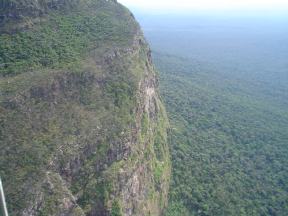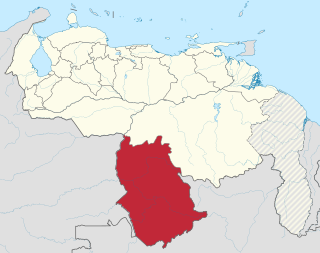
Amazonas State is one of the 23 states into which Venezuela is divided. It covers nearly a fifth of the area of Venezuela, but has less than 1% of Venezuela's population.

Trichomycteridae is a family of catfishes commonly known as pencil catfishes or parasitic catfishes. This family includes the candiru fish, feared by some people for its alleged habit of entering into the urethra of humans. They are one of the few parasitic chordates. Another species is the life monsefuano which was important to the Moche culture and still an important part of Peruvian cuisine.
Listrura is a genus of pencil catfishes native to South America.
Ammoglanis is a genus of pencil catfishes native to South America.
Pygidianops is a genus of pencil catfishes native to South America.
Typhlobelus is a genus of pencil catfishes native to South America.
The Sarcoglanidinae are a subfamily of catfishes of the family Trichomycteridae. It includes six genera: Ammoglanis, Malacoglanis, Microcambeva, Sarcoglanis, Stauroglanis, and Stenolicmus.
Ochmacanthus is a genus of pencil catfishes native to South America. These species are distributed in South America. O. alternus and O. orinoco originate from the Rio Negro and Orinoco River basins of Brazil and Venezuela. O. batrachstoma inhabits the Paraguay River basin in Brazil. O. flabelliferus lives in river drainages in Guyana and Venezuela. O. reinhardtii is known from the Amazon River basin in Brazil and drainages in French Guiana.

Henonemus is a genus of pencil catfishes native to South America.

The Atabapo Municipality is one of the seven municipalities (municipios) that makes up the southern Venezuelan state of Amazonas and, according to the 2011 census by the National Institute of Statistics of Venezuela, the municipality has a population of 9,169. The town of San Fernando de Atabapo is the municipal seat of the Atabapo Municipality.

San Fernando de Atabapo is a town in southern Venezuela on the border with Colombia. It was the capital city of the Amazonas state until the early 1900s. The population in 1997 was approximately 5,000.
Trichomycterus anhanga is a species of pencil catfish endemic to Brazil, where it occurs in the Amazon river basin in the state of Amazonas. This species reaches a maximum length of 1.3 centimetres (0.51 in) SL.

The Yapacana National Park Also Cerro Yapacana National Park Is a protected area with the status of national park in the South American country of Venezuela which was formed on December 12, 1978 by executive decree of President Carlos Andres Perez. It is located southwest of the confluence of the Ventuari River on the Orinoco River, in the jurisdiction of the Atabapo municipality of Amazonas state.
Stenolicmus ix is a species of catfish in the family Trichomycteridae- also called the Pencil or Parasitic Catfishes. It was described from the Curuá River, in the Brazilian state of Pará, which is part of the Amazon River basin.

Ammoglanis obliquus is a species of pencil catfish endemic to the Rio Preto da Eva drainage in the central Brazilian Amazon. This species reaches a length of 1.55 cm (0.61 in).
Ammoglanis pulex is a species of pencil catfish found in the Paria Grande River, the Pamoni River, and the Caño Garrapata in Venezuela. This species reaches a length of 1.5 cm (0.59 in).

Copionodon pecten is a species of catfishes of the family Trichomycteridae. It is found in the Mucujê River, a tributary of Paraguaçu River in Bahia, Brazil. This species reaches a length of 6.2 cm (2.4 in).
Ammoglanis diaphanus is a species of pencil catfish is found in a stream tributary to Javaés River, in the Araguaia River basin in Brazil. This species reaches a length of 1.9 cm (0.75 in).
Ammoglanis amapaensis is a species of pencil catfish and is found in the Rio Mapaoni, of the Rio Jari basin, in the Município Serra do Navio, at the Parque Nacional Montanhas do Tumucumaque, with a GPS coordinate of 2°11'39"N, 54°35'16"W, in the Estado do Amapá, Brazil. This species reaches a length of 1.8 cm (0.71 in).

The Amazonas Federal Territory is the name by which the current Amazonas State of Venezuela was known until 1992.








